With natural springs, forest ridges, and even caves, just the Ozark Plateau taking up most of the state’s southern half is diverse enough to keep the pickiest birds happy, but add in the northern plains and the abundant streams and you have a recipe for happy birds and birdwatchers alike! Today we will explore the birding highlights of the ‘Show Me’ state and give you a sampling of some of the local Avian elite that you can see if you live in or simply wish to visit Missouri. We’ll throw in useful data so that you know where to find them, what they like to eat, and more. Let’s talk about the popular backyard birds of Missouri!
3 Categories – 435 Birds
A lot of species make Missouri their permanent or temporary home and it’s understandable. With so many beautiful and varied environs available there is a little something for every bird. In order to keep things simple, we’ll give you a sampling of the local birds divided up into seasons so you’ll know when to look out for them. We’ll divide them like this:
- Year-round Resident birds
- Birds of Spring, Summer, and Early Fall
- Fall and Winter Birds
While we can’t promise that you’ll be able to lure them successfully to your backyard, we can give you enough information to give it a thorough ‘college try’. We know what they like to eat and what environments they are comfortable in, so the rest is going to be up to you and those fickle, little angels. Let’s start with the year-round residents and you can see what we mean!
Missouri’s Year-round Resident birds
These birds love Missouri when it’s hot, cold, or just right. At any time of the year you can catch them on fences or in woodlots, scoping out other birds and potential places to forage. Keep an eye out for these year-round residents and you might be pleasantly surprised:
- Northern Flicker
- White-throated Sparrow
- Tufted Titmouse
- Dark-eyed Junco
- Carolina Wren
Northern Flicker – Colaptes auratus
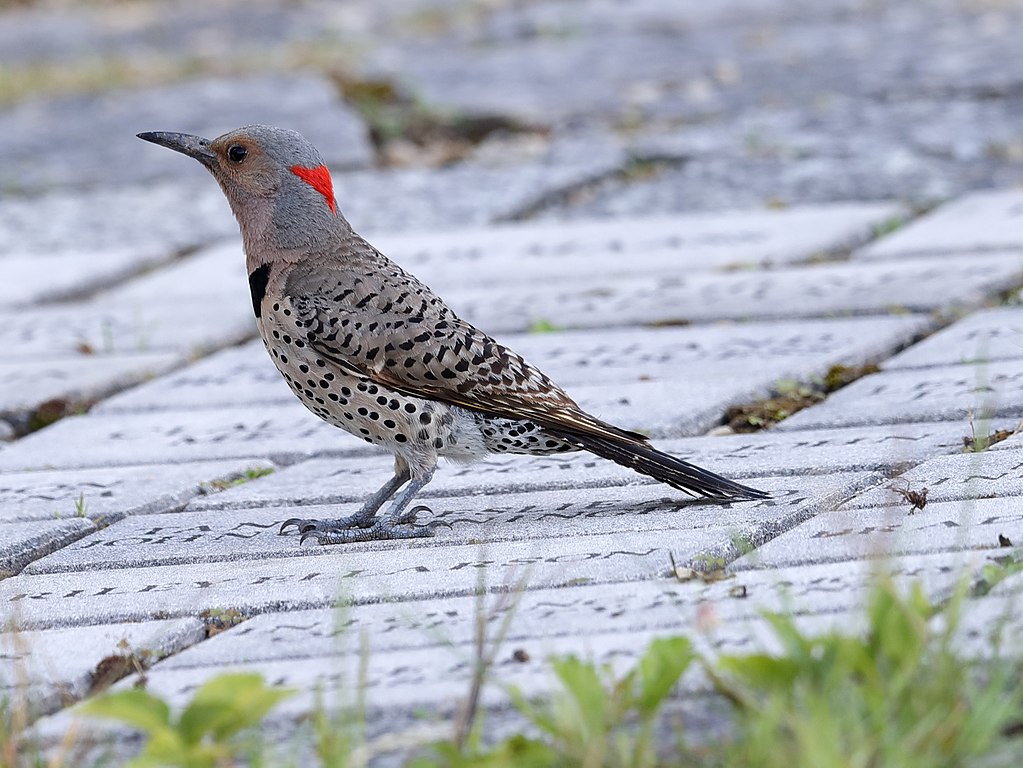
Coloration and Markings: Northern Flickers have some amazing markings and it’s no wonder… these are Woodpeckers! They have gray to brown backs and gray wings with mottled black patterns, made up of lines and dots and long, flared gray and black tails. The tails are orange on the underside towards the rump with black surrounding and underneath the wings you will see red or yellow, depending on whether you are in the west or the east. The breast and underbelly of this bird are white and light gray with black dots and just under the throat is a distinct black crescent mark. Facially, there is a color division at the center of the eye, with the face being brown above and ligrt gray or brown below. A red stripe crosses to the cheek from the bill and the eye appears to be outlined. This bird has a long, black and slightly curved bill.
Size: These birds measure in at 11 – 12.2 inches in length with wingspans of 16.5 to 20.1 inches.
Habitat: These birds love open areas, such as the forest’s edge, parks, fields, and backyards. When you are looking for one, don’t always look up, because these wily Woodpeckers like to ground-forage.
Diet: Northern Flickers like to eat ants but they do spice things up a bit, eating the occasional fruit, nuts, and seeds. For best results, try a little of everything by loading a ground feeder with peanuts, chopped apples, and Black Oil Sunflower seeds. These guys are a little shy about feeders but sometimes you can get lucky!
White-throated Sparrow – Zonotrichia albicollis
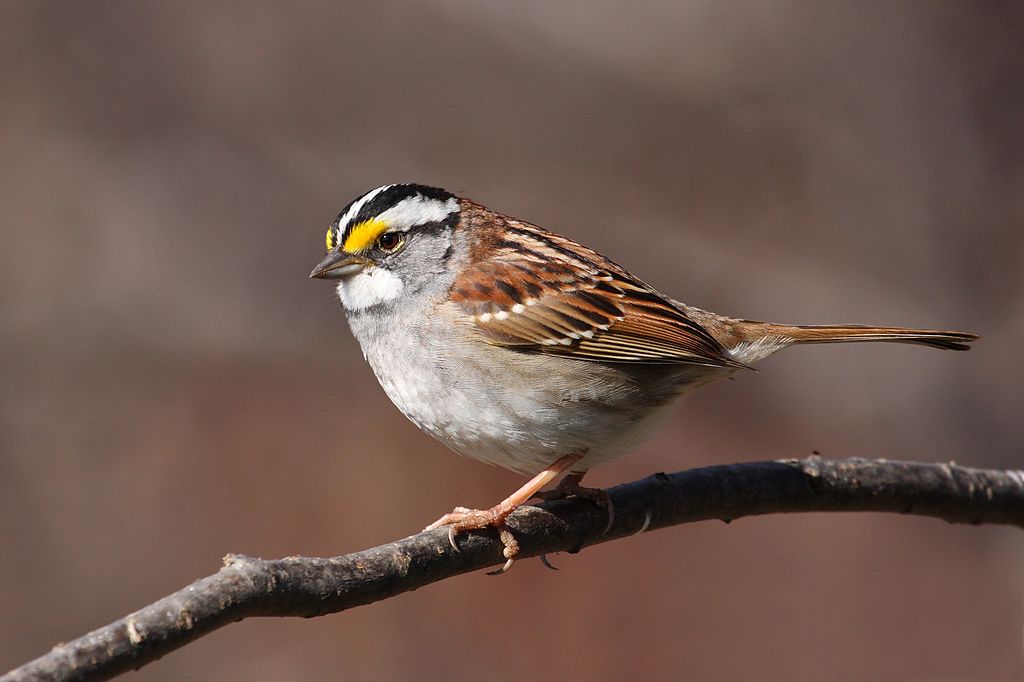
Coloration and Markings: White-throated Sparrows have brown backs, wings, and long, brown tails with minute black and white edging accenting the plumage. They have gray and white breast and underbelly, with the white coloration central while the gray displays as if it were a vest, showing on the sides and going up to just under the chin like a collar. Facially, these birds have gray on the lower half of their faces, excepting white underneath the bill to the chin, and above they have a large white eyebrow mark which turns yellow close to the bill and has a black line underneath it. This bird also has a ‘skunk’s cap’, with the top of the head having a central white stripe and black below it. These birds have small, slightly curved silver bills and if you see any Sparrows that fit this description but have brown and white on top then you’ve just witnessed a variety of White-throated Sparrow known as ‘Tan-striped’.
Size: These birds measure in at 6.3 – 7.1 inches from tip to tail with wingspans of approximately 7.9 to 9.1 inches.
Habitat: When it’s warm the White-throated Sparrow is most often inside the woods or at their edge or may be found near bogs or ponds. While they might still visit, the best odds for backyard visitation come in the winter when they range into parks, fields, and backyards the most.
Diet: White Proso millet and Black Oil Sunflower seeds are both favorites of this bird, so place one or the other (or simply make a mix of the two) if you see some White-throated Sparrows nearby. If that gets their attention then they might start spending more time in your backyard!
Tufted Titmouse – Baeolophus bicolor
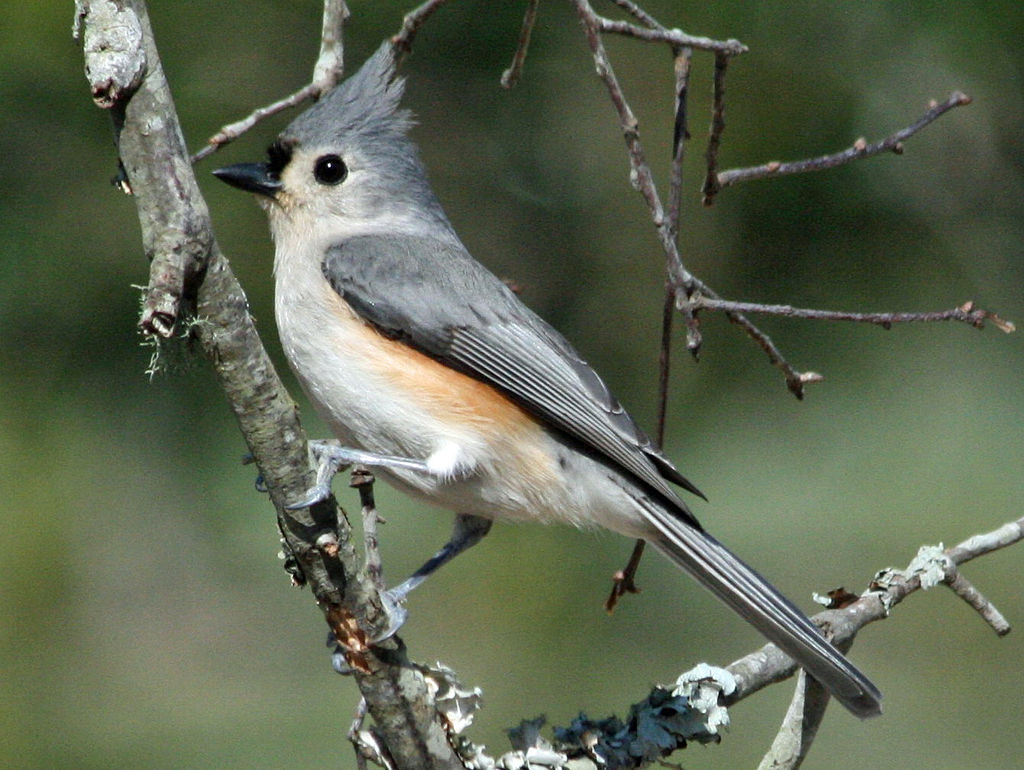
Coloration and Markings: The Tufted Titmouse is a lovely gray-blue on it’s back, wings, and on it’s medium-length, slightly rounded tail. The breast and underbelly are white, with a light flanking of peach coloration on the sides, and facially this bird has a beautiful blue-gray crest and the blue color takes up the top of the head and moves down, travelling dimly down the neck and giving the eyes a wide outline. The lower portions of the face are white and this bird has a telltale black square above its tiny, slightly curved black bill.
Size: These birds measure in at 5.5 – 6.3 inches in length with wingspans of 7.9 to 10.2 inches.
Habitat: These birds frequent Evergreen and deciduous woodlands but often range out into parks, gardens, and backyards with well-stocked feeders.
Diet: Lots of foods will make a Tufted Titmouse happy. You can feed them suet, peanuts, grapes, or Black Oil Sunflower seeds and these are just a few examples that will get you started. Once you’ve gotten a few repeat visits you can always mix things up to see if you can find their favorites!
Dark-eyed Junco – Junco hyemalis

Coloration and Markings: While there are slight differences based on region, in general the Dark-eyed Junco is going to be brown or a dark gray on its back, wings, and its long tail (although you might see some white on the tail). The breast will be white in the center but flanked with the upper body color and approaching the underbelly and the underside of the tail you will see all white. Facially, this bird has a dark gray or brown face with a short, stout pink bill.
Size: These birds measure in at 5.5 – 6.3 inches in length with wingspans of 7.1 to 9.8 inches.
Habitat: In the warmer months Dark-eyed Juncos spend most of their time in coniferous forests though they will sometimes range out and visit just about any open area. Fields, parks, and backyards are all fair game when it comes to foraging, so keep an eye out during the year (especially in winter) and you might just get a visit.
Diet: Set up a ground feeder with cracked corn, White Proso millet, and some hulled Black Oil Sunflower seeds and you’ll make any visiting Juncos very happy.
Carolina Wren – Thryothorus ludovicianus

Coloration and Markings: Carolina Wrens have rust-brown backs, wings, and medium-sized tails with the wings and tails edged in minute black and white squares. The breast and underbelly are yellow-orange and facially, these birds have white chin and cheeks, with some black underlining the eye below and a large eyebrow mark above. From the eye back and on the top of the head this bird is rust-brown and it has a medium-length, slightly curved black bill.
Size: These birds are 4.7 – 5.5 inches long with wingspans of approximately 11.4 inches.
Habitat: Brush piles are common haunts of these birds when they are hungry but most commonly they are birds of brambles, thickets, and shrubs, using the dense vegetation to shield them while they forage.
Diet: The best feeder food for luring the Carolina Wren in for a backyard visit is suet and peanuts. These are two of their favorites!
Missouri’s Birds of Spring, Summer, and Early Fall
When the wildflowers start to bloom and the Chickadees start singing then spring has arrived in Missouri. The fun continues through until early fall and there are a number of winged wonders waiting to meet you and see what you have left them in that feeder. Watch for the following birds of spring, summer, and fall:
- Blue-gray Gnatcatcher
- Eastern Wood-Pewee
- Brown-headed Cowbird
- Louisiana Waterthrush
- Purple Finch
Blue-gray Gnatcatcher – Polioptila caerulea

Coloration and Markings: The Blue-Gray Gnatcatcher looks almost like a cartoon bird. This bird has a blue-gray back with short wings of the same color with a little black highlighting towards the tips and a medium-length tail which is black on top and white underneath. The breast and underbelly of this bird are snow white and this white continues upward until just under the eye, moving levelly across the face to the back of the neck and visible in front of the wings. The top half of this bird’s face is blue-gray, with a thick, black eyebrow mark that makes this plump little guy look angry. A white eyering is present and this bird has thin, medium-length straight bill.
Size: These little birds measure in at 3.9 – 4.3 inches in length and have a wingspan of approximately 6.3 inches.
Habitat: These birds spend their time within and at the edge of deciduous forests and anywhere that there is dense vegetation for cover. If you have some shrubs in your garden then this will increase your chances of a visit, as it makes these birds feel safer.
Diet: These birds love insects and prefer to catch their food live, so you may not have a lot of luck with the feeder. You can try dried mealworms and crickets, however, and if they notice then you might get a feeder visit.
Eastern Wood-Pewee – Contopus virens
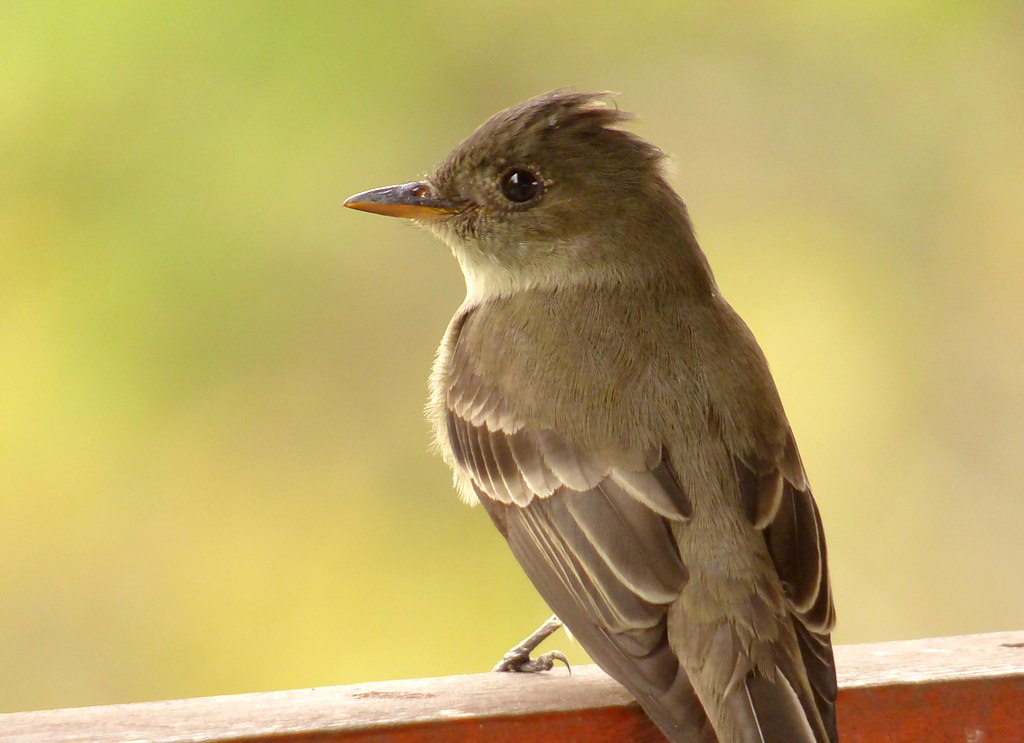
Coloration and Markings: Eastern Wood Peewees have simple but lovely coloration. These birds have dark gray back, wings, and long, dark gray to black tails. The wings have 2 thin wingbars each and some white edging defines them nicely. The breast and underbelly of this bird are dirty white with a central spot on the breast sometimes visible which is completely white. Facially, these Pewees have gray crest and face, with a medium-length bicolor bill which is black on top and yellow on the bottom.
Size: These birds are approximately 5.9 inches from head to tail with wingspans of 9.1 to 10.2 inches.
Habitat: These birds love the forest, especially if it is of the deciduous variety. When not in the woods, they like open areas and will happily visit your backyard but may be too shy to visit the feeder.
Diet: These birds are shy about feeders but they do like berries, especially raspberries and blueberries. Try adding these, either dried or fresh, and you might just have a little luck if the Eastern-Wood Peewee notices.
Brown-headed Cowbird – Molothrus ater

Coloration and Markings: The Brown-headed Cowbird looks like a Blackbird from a distance but when it’s closer you will notice a simple difference. While the male Cowbird does have a completely black back, with long black wings and a short black tail, breast, and underbelly, the head is simply brown. The bill is a short, black, and stout. Female Cowbirds, by contrast, are completely brown but will have lighter brown on their heads, breast, and underbelly and some streaking is present on the underbelly.
Size: These birds measure in at 7.5 – 8.7 inches in length with wingspans of 12.6 to 15 inches.
Habitat: Cowbirds like open areas and tend to ground forage, though they also like lofty limbs for surveying. These birds have a bit of a bad reputation for eating the eggs of other birds.
Diet: These birds like insects, fruits, and grains, so if you want to lure one closer you can try some chopped apples and White Proso millet. Use a ground feeder to maximize your chances.
Louisiana Waterthrush – Parkesia motacilla

Coloration and Markings: The Louisiana Waterthrush has a dark brown (or sometimes brownish gray) back, wings, and a short, dark brown tail with a breast and underbelly that is white with brown streaking. This pattern continues up to just under the bill on this bird and outlines the underside of its cheek. From the cheek up, this bird has a brown face with the exception of a thin eyebrow line from the bill to the back of the head and part of an eyering which underlines the eye. This bird has a thin, medium length black bill.
Size: This bird measures in at 5.9 – 6.1 inches in length with a wingspan of 9.4 to 10.6 inches.
Habitat: These birds go where the water is, so look for them by streams or rivers and you might just sight a Louisiana Waterthrush fishing for lunch or dinner.
Diet: While these birds mostly eat insects, crustaceans, and small fish, they will sample seeds on occasion. You can try Nyjer thistle and small Black Oil Sunflower seeds but we can make no guarantees as these birds prefer fishing for their supper.
Purple Finch – Haemorhous purpureus
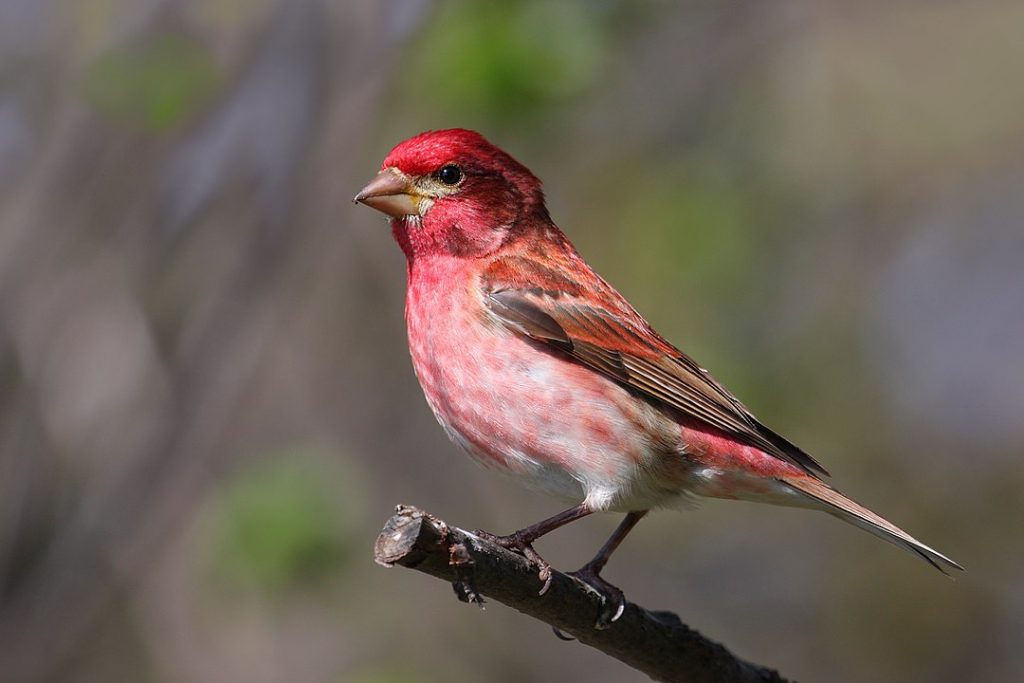
Coloration and Markings: The male Purple Finch is easy to recognize and quite the looker, with brown wings that are raspberry-stained and accented at the shoulders with some minute white edging. They have short, notched gray tails which are white at the tips and the breast and underbelly are white with raspberry streaking. This streaking is heavier at the breast and lessens as the coloration travels down the underbelly. Facially you will notice that from the throat up this bird’s face is completely raspberry but some markings are a richer color. Typically this will manifest as a deeper raspberry as a thin stripe at the top center of the head, a line on the lower face outlining the cheek, and a raspberry mask travelling on a curve downward after crossing the eyes. Females, by contrast, wil not have the raspberry hue and will have denser streaking at the breast, as well as a lighter eyestripe and also a dark line that shows clearly on its throat. These birds have large, stout and conical gray bills with a splotch of black on often present on the upper half of the bill.
Size: These pretty little birds measure in at 4.7 – 6.3 inches in length with a wingspan of 8.7 to 10.2 inches.
Habitat: These birds love the woods, with coniferous being their favorite and deciduous following closely. They will sometimes visit parks and the frequency of this increases in the winter, where they also range into fields and their backyard visits become much more regular as they look for food.
Diet: The Purple Finch is quite easy to please, preferring Black Oil Sunflower seeds the most when it comes to the average feeder setup. It’s a favorite of this bird so be sure to leave out plenty to get their attentions!
Missouri’s Fall and Winter Birds
With lows around 20 degrees Fahrenheit and cold temperatures for an average of 110 days a year, winter can be a little rough for some birds. Not Missouri’s fall and winter birds, though. These little action heroes with wings chirp defiantly at the cold and not only endure, but thrive. Keep an eye out for the following fall and winter birds of Missouri:
- Downy Woodpecker
- American Robin
- European Starling
- Lapland Longspur
- Fox Sparrow
Downy Woodpecker – Picoides pubescens
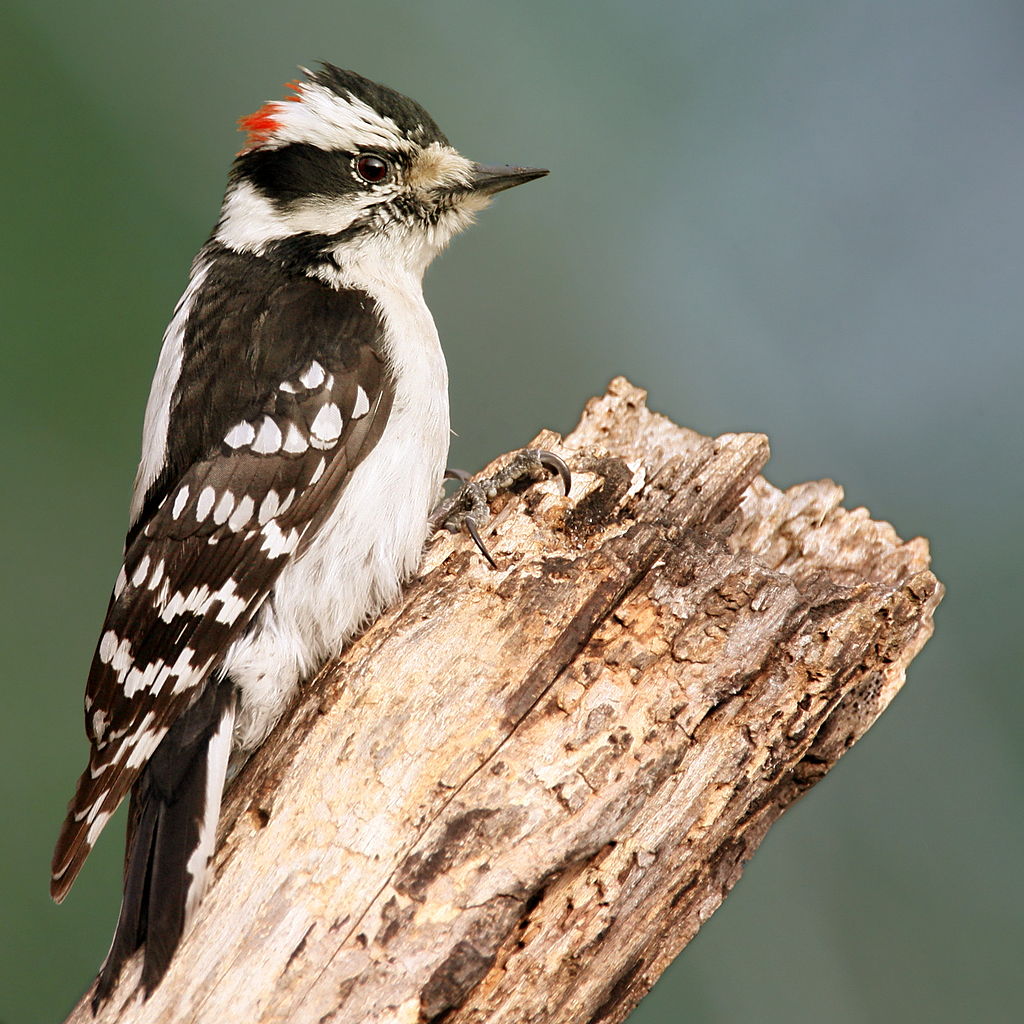
Coloration and Markings: Do you like Woodpeckers but feel that, on the whole, they are a little on the large side? See if you can spot one of these guys. Downy Woodpeckers are easy to identify, with white backs and black wings which have lines across them made of white blocks and spots. These produce a checkered effect on the wings and further down this bird has a short, black tail with white undersides and outer feathers. The breast and underbelly of this bird are snow-white and this color continues up into the face, disturbed only by a black mustaches line, a mask-band which goes from the front of the eye to the back of the head, and a black cap. In males this cap will have a distinctive red spot at the back of the head. This bird has a small, thin black bill.
Size: These mini-Woodpeckers measure in at a mere 5.5 – 6.7 inches in length with wingspans of 9.8 to 11.8 inches.
Habitat: These birds love open wooded areas, so look for them in meadows or at the forest’s edge. They also like areas with high brush or untended weeds and when they range out they are frequent visitors to parks and backyards.
Diet: These birds really like suet but if you don’t have any on hand, they’ll gladly eat chunky peanut butter, peanuts, Black Oil Sunflower seeds, and White Proso millet. Rumor has it that they like to sample Hummingbird feeders as well for a little sugar water. Indulge this little bird’s sweet tooth and you might just make a new friend.
American Robin – Turdus migratorius
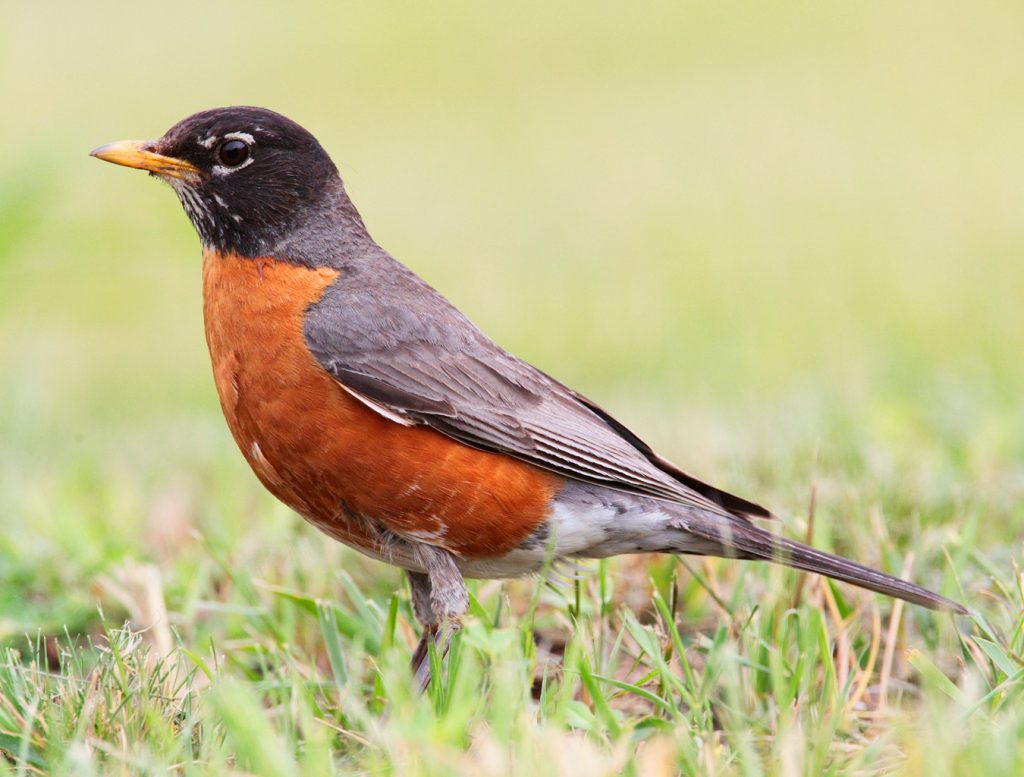
Coloration and Markings: The American Robin has quite a distinctive appearance, with a grayish-brown back, long wings of the same color, and a darker gray-brown at its long tail. The tail is white on the undersides, with the white coloration originating from the bird’s rump, and the breast and underbelly are a soft or heavy dark orange color which goes all the way up until just under the chin. Facially, this bird has a black head with a small amount of white under its short, curved yellow bill and you’ll also notice a fragmented white eyering. Females will appear much the same, with the exception that they will have lighter coloration on the head.
Size: These birds measure in at 7.9 – 11 inches in length with wingspans of 12.2 to 15.8 inches.
Habitat: American Robins range far and wide, so you can find them sometimes in Evergreen or deciduous woods or just as easily at a golf course. Parks, pastures, and overgrown fields are also regular foraging sites for these birds and they are more than happy to visit well-stocked backyard feeders.
Diet: These birds are omnivores so there are a lot of different food choices. Try going the fruit route, with some chopped apples and whatever berries you have on-hand. Robins love fruits when they aren’t eating insects and you can get some good results.
European Starling – Sturnus vulgaris
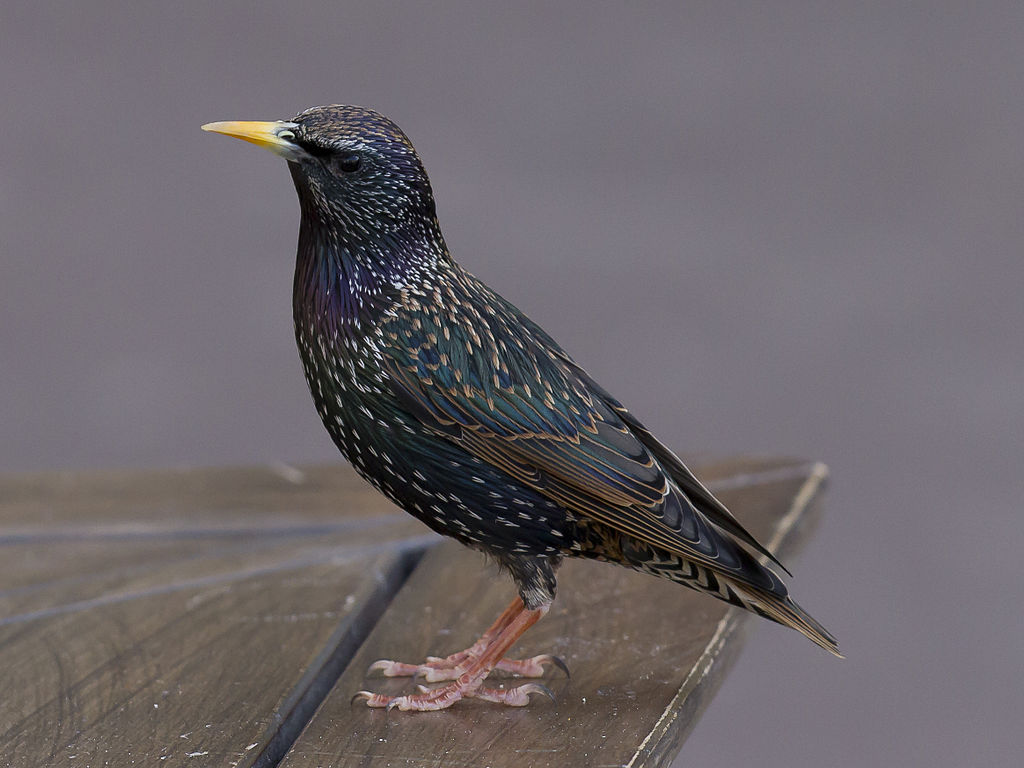
Coloration and Markings: European Starlings are easy to identify, with purple-green hues in their plumage when viewed up close. This covers their entire bodies but another quick identifying trait is their long, straight yellow bills. In winter, they molt out of this shiny plumage and replace with brown coloration peppered with white spots.
Size: These birds measure 7.9 – 9.1 inches in length and have wingspans averaging between 12.2 to 15.8 inches from wingtip to wingtip.
Habitat: These birds are actually just about anywhere that we are. They prefer areas where people have settled, be that on a farm, town, or city. You might see one on a telephone wire or walking on the sidewalk, as their long cohabitation has made them quite comfortable around humans.
Diet: These birds have quite the varied diet. When not eating insects they like berries, seeds, grains, and more. Grains are a good way to go and some White Proso millet, wheat, and oats in your feeder may lure a European Starling in for a visit and it might well come back for more. These guys love grain a little TOO much, in fact, and are sometimes considered a nuisance as they raid grain stores and this raises contamination worries.
Lapland Longspur – Calcarius lapponicus

Coloration and Markings: Lapland Longspurs are pretty but look a bit odd the first time that you see them. They have white back, wings, and tail but the back and shoulder area will have black or dark brown streaking which continues down the wings but is not present on the short, gray-to-brown tail. These birds have a white breast and underbelly, with a small amount of black or brown streaking flanking the white. Facially, these birds have a distinct rusty-red coloration on the backs of their necks, as well as a small black cap and a mostly-black face, with black coloration starting at mid-eye level and framing the cheek as it moves to the base of the throat. The remaining central portion of the face is white and these birds have short, stout yellow bills. We should note that in the winter these birds molt and replace their plumage with light, streaked brown, though they will still retain the basic face pattern and should be recognizable.
Size: These birds measure in at 5.9 – 6.3 inches in length with wingspans of 8.7 to 11.4 inches.
Habitat: These birds aren’t afraid of the snow and prefer to breed and forage in open areas. This includes coastal areas, fields, turf farms, parks, and even backyards. The Lapland part of their name refers to a region in Scandinavia so these little guys are quite hardy when it comes to chilly temperatures.
Diet: These birds primarily eat insects but they supplement their diet with seeds. You can try setting up a ground feeder with some Nyjer thistle and some small Black Oil Sunflower seeds but we can’t make any promises that this will work. While they might well visit your backyard, these birds can be a little shy about feeders. That said, these seeds are your best bet with the Lapland Longspur.
Fox Sparrow – Passerella iliaca
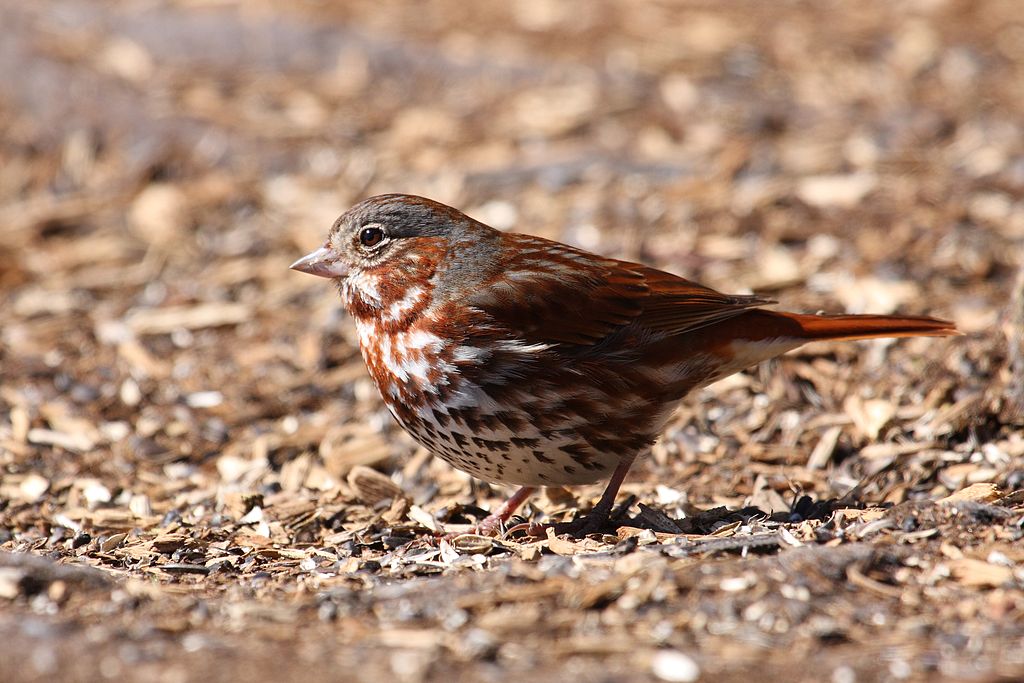
Coloration and Markings: Fox Sparrows can have a lot of regional variance in their coloration but typically you want to look for a bird with a ‘fox brown’(warm reddish-brown) color on their backs, wings, and medium-length tails. The tails will be grayish white on the underside and there will be reddish-brown streaking on the back. The breast and underbelly of this bird are grayish-white with brown streaking that carries up until just under the bill. Facially, these birds have brown faces, with a white mustache line and a thick, gray line at mid-eye level which crossed the eye and often with another broad gray line starting under the cheek and moving to the back of the head. These birds have short, slightly curved grayish or yellow bills.
Size: These Sparrows measure in at 5.9 – 7.5 inches in length with wingspans of 10.5 to 11.4 inches.
Habitat: These birds divide their time between the forest and dense vegetation in mountainous regions. Winter gets them to ranging and they become frequent visitors to backyard feeders at this time. Leave a little something out for them to help bolster against the cold and you might just make some new friends.
Diet: Fox Sparrows like to eat insects, small crustaceans, seeds, and berries. They are ground foragers, so try putting out a ground feeder with some chopped up cherries or whole blackberries with a mix of Nyjer thistle and Black Oil Sunflower seeds on the side. You can add mealworms or dried crickets for good measure, if you like, for a little protein boost to help ward off the chill.
Supporting cast (Other Backyard Birds of Missouri that might pay you a visit)
Our first category of year-round birds shouldn’t get all of the attention. We’ve collected 5 more birds that you can look for at any time of the year that are all quite beautiful and well worth your time. Our year-round ‘Supporting Cast’ birds are as follows:
- Mourning Dove
- Black-capped Chickadee
- House Finch
- Eastern Bluebird
- House Sparrow
Mourning Dove – Zenaida macroura
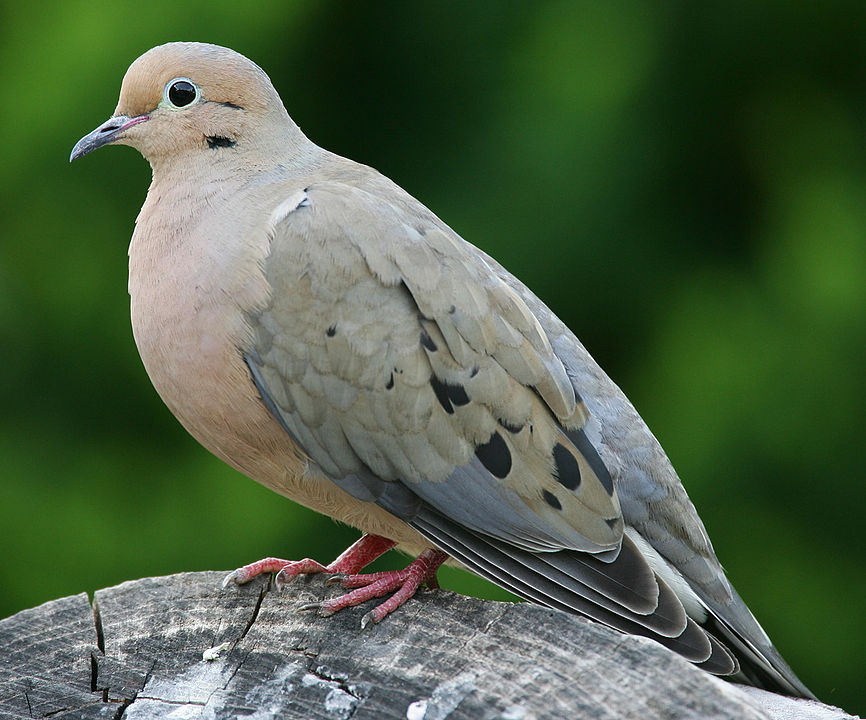
Coloration and Markings: Mourning Doves are pretty, plump creatures, with soft gray back, wings, and medium-length white-tipped tails. The wings have a large concentration of creamy tan or light brown color and distinctive black spots are present from the middle of the wing to close to the tips. They have a white and tan breast and underbelly that lightens as it approaches the rump and facially, these birds have a deeper concentration of tan color and short, straight black bills. The Mourning Dove will also have a distinctive white eyering present, completing the look and confirming your identification.
Size: These birds measure in at 9.1 – 13.4 inches in length with a wingspan averaging 17.7 inches.
Habitat: These birds love open areas so you can commonly see them in spacious parks, open fields, or even strolling on the sidewalk. They are not shy when it comes to people and will be more than happy to visit a well-stocked backyard feeder.
Diet: Mourning Doves don’t need anything complicated. A simple mix of White Proso millet and Black Oil Sunflower seeds will keep them happy and coming back for more.
Black-capped Chickadee – Poecile atricapillus
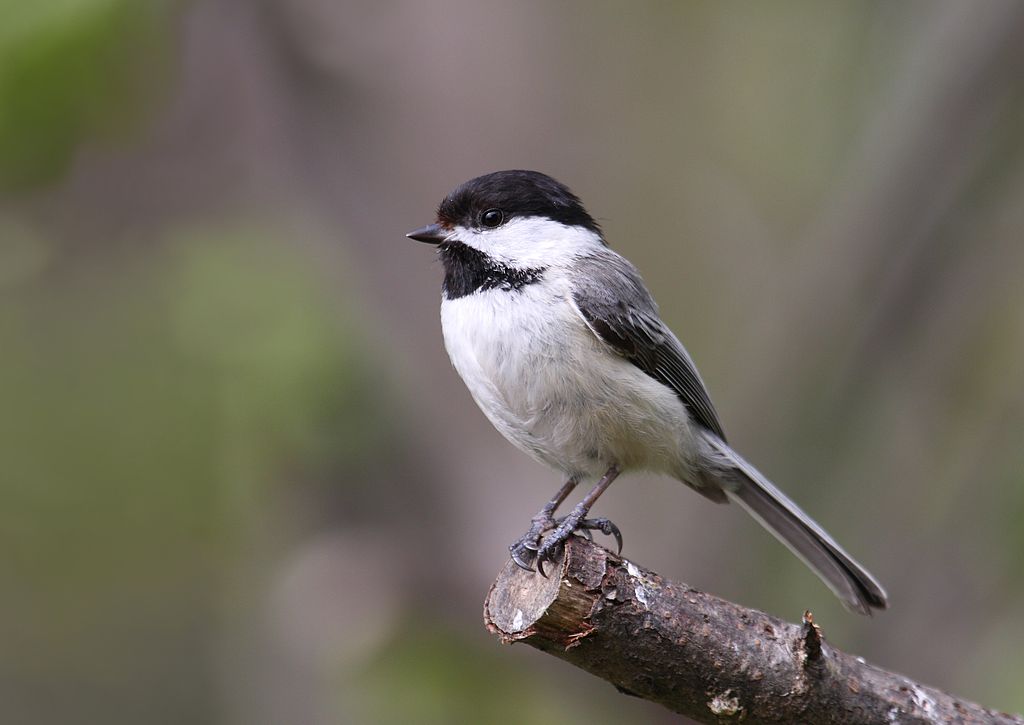
Coloration and Markings: Black-capped Chickadees are beautiful and easy to identify. They have velvety-gray backs, short gray wings with white highlighting, and medium-length, dark gray tails which are white on the undersides. Their breast and belly is a brilliant white and facially they are white as well, with the exception of a black bib that goes down to chin level and a large black cap that levels over the center of the eye. These birds have tiny, conical black bills.
Size: These cute little guys measure in at just 4.7 – 5.9 inches length and they have wingspans of 6.3 to 8.3 inches.
Habitat: These birds love trees and dense vegetation. Of the former, Alder and Birch trees are two of their favorites when it comes to nesting and the latter means that you can find them anywhere that there is thick cover. Marshes, weedy fields, bushes, brambles, and thickets… If you happen to have any shrubs in your yard then your chances definitely go up for a visit but if not, don’t worry, these guys still love a well-stocked feeder and might just come for a visit for this alone.
Diet: Black-capped Chickadees are not too picky and you can get a lot of mileage with a simple fare of peanuts, suet, and Black Oil Sunflower seeds.
House Finch – Haemorhous mexicanus
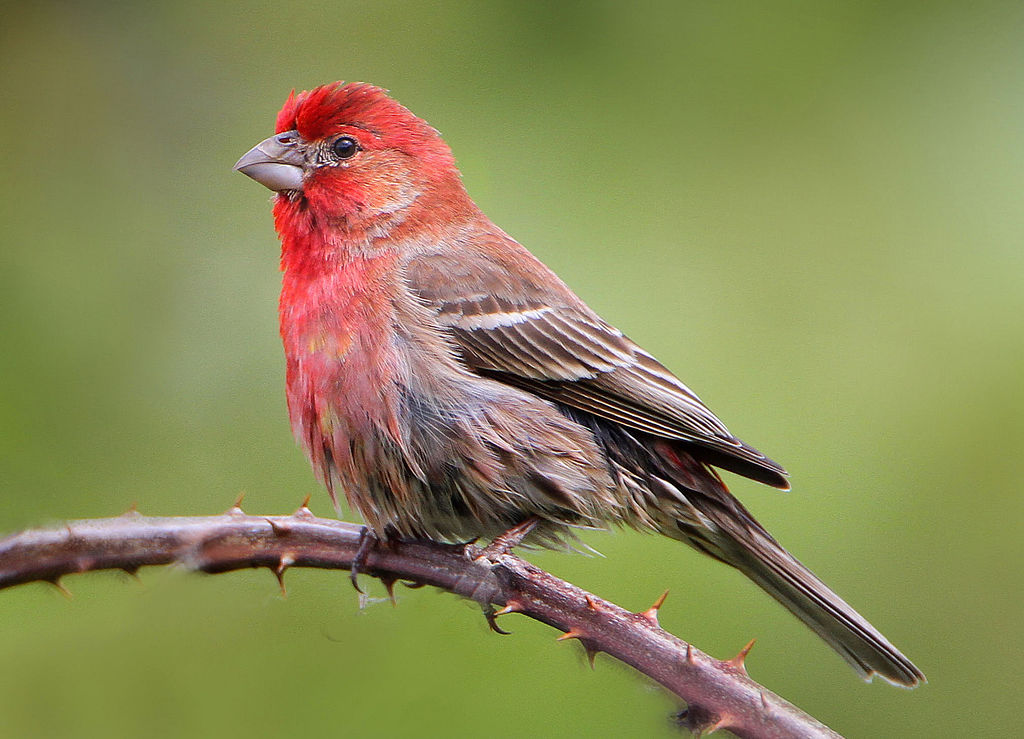
Coloration and Markings: Male House Finches have stunning coloration, with their back, wings, and medium length tails being a soft gray. The wings show vertical black lines that accent them nicely and their notched tails are white on the undersides and lightly white-edged at the tips. Their breast has a heavy concentration of rosy-red color on top of white or off-white which lightens into faint red streaking as it approaches the lighter underbelly. Facially, this bird is a deeper rosy-red with a gray eyeline which typically zigzags down to the cheek and the back of the neck. This bird has a short, stout, and silvery bill with a noticeable curve to it. Females do not have the same vibrant red coloration, but rather an unmarked face and a grayish-brown color overall and heavy, dark and light streaking.
Size: These birds measure in at 5.5 – 5.5 inches in length with wingspans of 7.9 to 9.8 inches.
Habitat: When not spending time at the forest’s edge, House Finches are town and country birds. You can find them at farms, parks, and backyards and they are more than happy to visit your feeder… provided that you have prepared a little in advance.
Diet: House Finches like Black Oil Sunflower seeds and White Proso millet but they also have a sweet tooth for fruits. They like apricots, plums, peaches, strawberries, and more! So if you really want to spoil these guys be sure to leave out some Sunflower seeds with a little dessert fruit on the side. You’ll be happy that you did!
Eastern Bluebird – Sialia sialis
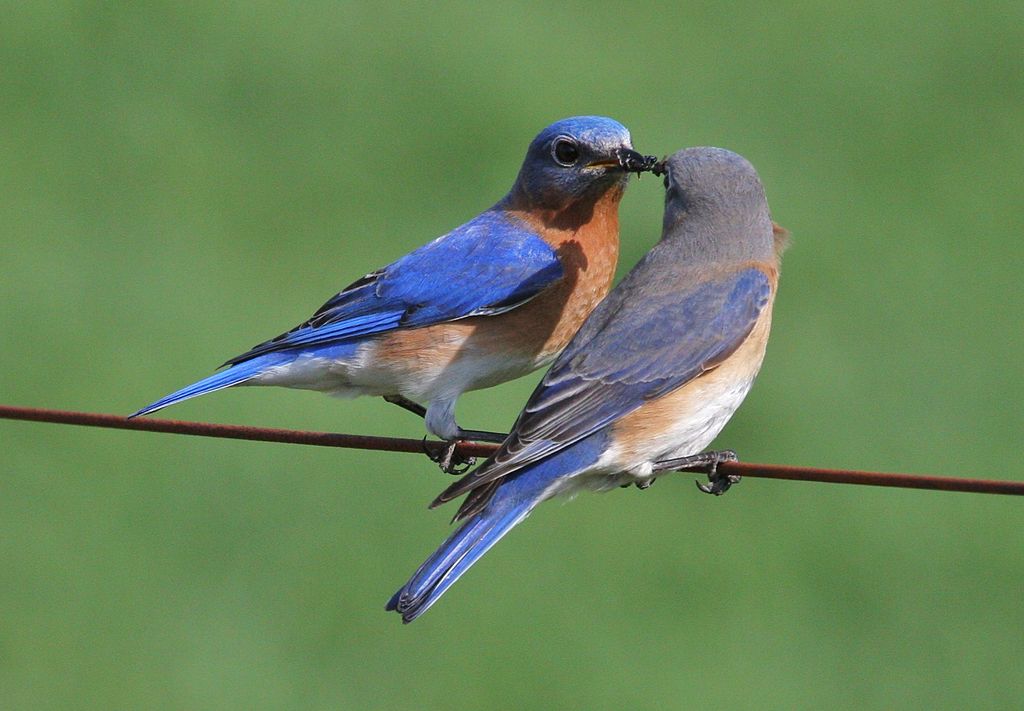
Coloration and Markings: Male Eastern Bluebirds are handsome little fellows, with blue back, short blue wings with black tips, and little blue tails. They have an orange-red vest and this orange color goes up where it manifests like a throat-collar, going above the wings and across to underneath the chin. As the color approaches the underbelly it becomes a flanking color, with the underbelly and rump being white to slightly ‘dirty’ white. Facially, the top halves of these bird’s faces are blue and they have medium-length, slightly curved gray bills. Females tend to be more grayish above and the orange-red is much more subdued but very much recognizable.
Size: These birds measure 6.3 – 8.3 inches in length and have wingspans of 9.8 to 12.6 inches.
Habitat: These birds like meadows, golf courses, parks, and other open areas. If you have a roomy backyard then you might just end up one day with a Bluebird as your guest!
Diet: Eastern Bluebirds are a little shy about feeders but you can give them a nudge in the form of dried crickets or mealworms. This might tempt them out of hiding to partake of some tasty treats.
House Sparrow – Passer domesticus

Coloration and Markings:
Size: These birds measure in at 5.9 – 6.7 inches from tip to tail with wingspans approaching 7.5 to 9.8 inches in length.
Habitat: These birds have been living with us for a long time, so when it comes to spending a little ‘Nature time’ the closest they like to come to woods is going to be a farm. They are much more comfortable in towns and cities and quite happy to come visit your backyard. Be sure to leave a little something out for them!
Diet: House Sparrows like cracked corn, White Proso millet, and Black Oil Sunflower seeds. Stock up on these and watch the fun!
Missouri Bird Buffet
The Great Missouri Birding Trail has some advice to offer when it comes to luring the most birds to your feeder with the careful selection of favorite foods. We’ve added a few suggestions of our own but if you want to see the undiluted list or hear a little more of what the Great Missouri Birding Trail has to say then simply take advantage of our reference link here:
Without further ado, here are our combined recommendations for making your own super-feeder:
- Black Oil Sunflower
- Safflower seeds
- White Proso millet
- Assorted fruits
- Cracked corn
- Grape or strawberry jelly
- Peanuts
- Chunky peanut butter
Missouri Birding Hot Spots
The Chirparazzi have a lot of experience when it comes to tracking down the popular birds in the spotlight today. We’ve got a few hot tips about where you can go to catch a glimpse or maybe even a photo of a few of the celebrities yourself. In order to accommodate folks who live in various parts of the state and visitors to Missouri we have selected locations as close to the compass points and the central part of the state. Be sure to take advantage of the link below if you find that these spots are a little too far and before you know it you can see the stars at play where they feel most at home. Be sure to visit one or more of the following hotspots:
- Northern hotspot – MKT Nature and Fitness Trail
- Eastern hotspot – Mississippi Greenway
- Southern hotspot – Table Rock Lakeshore Trail
- Western hotspot – Highline Trail
- Central hotspot – ACORN Trail
Detailed descriptions of each location as well as information regarding visiting and what birds you can see at these locations may be found at: https://www.traillink.com/stateactivity/mo-birding-trails/
Some Final Words
Today we have talked about the popular backyard birds of Missouri and we hope that the tips that we’ve provided will be of good use to use. Be sure to set out the birdbath, stock of the feeder, and give everything a fresh cleaning in spring because Missouri has a lot of birds just waiting to visit. Just be sure to leave out a little of what they like and see what happens. We think that you’ll be quite happy with the results!
